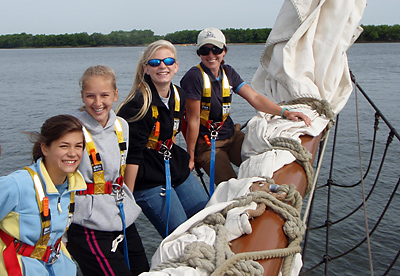
 CHARLESTON—Students from Charleston Catholic School embarked on their trip aboard the Spirit of South Carolina as individuals, but they disembarked as a team.
CHARLESTON—Students from Charleston Catholic School embarked on their trip aboard the Spirit of South Carolina as individuals, but they disembarked as a team.
Teachers and youth who went on the excursion praised it as a learning and bonding experience like no other, and recommended it as a class trip to every school.
Fred McKay, principal, said the eighth-grade class takes a trip every year, and he thought the three-day, two-night sailing gig would be a fun and unique learning experience.
He was right.
Although the chaperones and some of the students were apprehensive beforehand, they were quickly put at ease by the Spirit’s crew.
Ivan Fields, homeroom teacher, praised the sailors for their wonderful teaching abilities and rapport with the students.
A total of 16 students, two chaperones and nine crew members sailed the pilot Schooner around the waterways of Charleston, Mount Pleasant, Daniel Island, James Island and Johns Island, Fields said. They even went past the jetties a bit, but never lost sight of shore.
Many of the students wrote e-mails to The Miscellany about the variety of aquatic life they saw, including hundreds of colorful cannonball jellyfish, playful dolphins, and a school of stingrays. Each time, the group would point and shout with excitement.
At night, when the world was dark, they could see the glow of bioluminescent plankton.
Fields said they were also blessed with what crew members described as a rare sight when right whales were spotted in the harbor.
“Things could not have gone any better,” said Rollins Babb, English teacher. “It was a wonderful learning experience for the kids and [the teachers].”
 She said the students discovered something even more important than aquatic life and nautical terms. “They found out there is life outside their own lives. It really allowed them to become a team.”
She said the students discovered something even more important than aquatic life and nautical terms. “They found out there is life outside their own lives. It really allowed them to become a team.”
Babb said that is an extremely important lesson for an age group that spends so much time poking fun at each other.
When the students first climbed aboard, they were told in no uncertain terms that individual needs were not a priority on a sailing vessel. First was the ship, then shipmates, with self always last.
It takes five people just to raise a sail, so teamwork is a necessity.
Babb said everyone learned the terms and duties quickly and jumped right in to help, never looking around to see who else could do it.
One of the jobs was nighttime anchor watch. Teams of two or three plus one crew member worked in 1½ hour shifts to make sure the boat did not drift from its spot.
The teacher groaned a bit when she talked about her 4 a.m. watch time, but added that it turned out to be very peaceful.
After going through a regimented check list, the students on anchor watch spent their little bit of downtime adding lines to an ongoing story that Babb said turned out really funny.
In addition to journaling, the teens applied science and math to what they saw and learned about aquatic life and sailing.
By the last day, Fields said the students were pretty much sailing the boat as a crew.
“They were really moved by the fact that they were responsible for powering the boat,” Babb said.
Aside from marine animals, one of the most enjoyable aspects for the teens was the bow sprit. From here they could watch the ocean pass below, and when at anchor they jumped from the point to go swimming.
Babb said she liked the time devoted each day to quiet sail, when the only noises were the waves and sounds of the boat.
But not all aspects of sailing life were popular.
One of the most important duties, and the one liked least by the students, was bow watch. The person on bow watch was responsible for keeping an eye out for anything that might cross the ship’s path, and could not eat, drink or speak to anyone while on duty.
But Babb said no one complained, questioned or whined. They just jumped in and did it.
 “It was three days of kindness,” she said, adding that she would like to see the eighth-grade class take this trip every year.
“It was three days of kindness,” she said, adding that she would like to see the eighth-grade class take this trip every year.
Charleston Catholic has a special connection to the Spirit of South Carolina through eighth-grader Marybeth Bayne, who was on the cruise. Her father, Mark Bayne, is the owner of Sea Island Shipwrights in Charleston and is the ship’s master builder.
The Schooner has room for 30 people, including crew, on an overnight trip and 50 on a day sail, according to the website www.scmaritime.org.
Three sleeping quarters hold individual bunks and a curtain that can be drawn for privacy. Everything a person brings on board must be stored in their bunk.
McKay said the venture cost about $9,000, which is comparable to other trips once transportation, hotel accommodations and food are factored into the total.
The school helped offset the price through a variety of fundraisers, including a golf tournament run by parents; the eighth-graders’ weekly Sweet Shop that sold goodies to other students; dinners at PTO meetings; and even a babysitting service at the annual oyster roast.
